The coral reefs at the foot of Florida are legendary, making up a barrier reef that spans more than 255 continuous miles. The reefs are home to lobster, sea turtles, fish, and more, and they have protected the coastline from storm surge for thousands of years. But these coral reefs, like coral reefs across the globe, are in serious trouble.
In recent decades, the coral reefs within Florida Keys National Marine Sanctuary have been damaged by hurricanes, bleaching, disease, and heavy human use. The sanctuary and its partners are working diligently to protect the reefs, but our efforts have not been able to keep up with the decline. Now, NOAA and our partners are launching Restoring Seven Iconic Reefs: A Mission to Recover the Coral Reefs of the Florida Keys, one of the largest investments in reef restoration anywhere in the world. By restoring corals at seven iconic reef sites in Florida Keys National Marine Sanctuary, we can change the trajectory of an entire ecosystem and help save one of the world’s most unique areas for future generations.
More than 6,000 species of plants and animals call the Keys home, and many are found on the coral reefs. Recreationally and commercially important fish species shelter and feed on the reefs, as do spiny lobster, sea turtles, and more.
In addition to supporting diverse animal and plant life, the coral reefs of the Keys are important for the survival of human communities throughout this island chain. Structurally, the corals create a barrier between the islands and the open ocean, dissipating wave energy and diminishing the impacts of storms and high tides. And they also form the basis of the Florida Keys economy: 5 million people visit each year – most of whom participate in ocean recreation and enjoy the reefs – contributing $2.4 billion in sales annually. Here, more than one out of every two jobs is connected to the marine ecosystem.
Continue reading at NOAA National Marine Sanctuaries
Image via NOAA National Marine Sanctuaries


